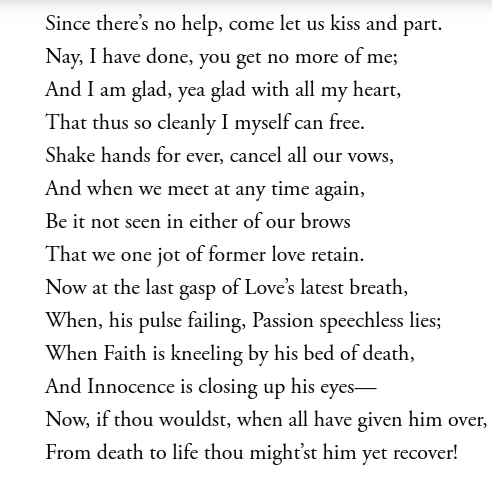Introduction
In this poetry review, I will explore how the poet, Micheal Drayton, uses language to convey the complex relationship between the narrator and a “beloved”. Drayton uses a first person POV that later transitions into third person POV to articulate the narrator’s heartache. The tone of the poem fluctuates between detachment and sentimentality.
The poet uses figurative language to enrich the poem’s emotional complexity. The narrator’s opening line, “Since there’s no help, come let us kiss and part,” sets the tone for sentimental tension between two people at a crossroads (1). Words like “no help,” and “part,” suggest a finality to the end of the relationship yet, the invitation to “kiss” in the same breath indicates that their finality is entwined with affection (1). The “kiss” can be interpreted as a metaphor for tenderness that still lingers, even in the face of an inevitable end. This is Drayton’s representation of the duality of loving someone but knowing the relationship must end, creating an emotional paradox.
Detachment
Even though there are feelings of nostalgia and tenderness present, the narrator is briefly written with a bitter tone mixed with signs of denial over his heartache. “And I am glad, yea glad with all my heart,” sounds like the narrator is trying to convince himself of being better off now that he “can free [himself]” (3-4). The next line alludes to a changing future, one that is no longer shaped by preexisting plans or being tied down. The act of “[canceling] all our vows,” is representative of forgetting about what more could have been, and focusing on why separation is requisite. The language conveyed here is cold and distant because ultimately life goes on.
The line, “Be it not seen in either of our brows that we one jot of former love retain,” shows that there remains a lingering bond (7-8). However, it is conveyed more complex rather than just a simple break through Draytons choice of concealing strong emotion from being visually apparent in each other’s presence. The narrator’s words can be more easily transcribed to– let it never be revealed to one another that we wish to rekindle our love. There’s a sense of uncertainty between them; they have given up, but have also expressed that they care.
Sentimentality
Now at the last gasp of Love’s latest breath, When, his pulse failing, Passion speechless lies; When Faith is kneeling by his bed of death, And Innocence is closing up his eyes— Now, if thou wouldst, when all have given him over, From death to life thou mightst him yet recover!”[/pullquote]
Here, in the poem’s last sentence, Drayton uses metaphors of death, passion, faith, and innocence expressed by a 3rd person narrator to describe the end of love, personifying love as a dying person. The poet describes how love is on its “latest breath,” with its “pulse failing,” concluding its final moments between the two subjects (8-9). Passion is also characterized here with the purpose of saying that there is none left, it’s “speechless,” (10). However, it’s important to acknowledge “faith,” remaining even whilst passion and love have died because it draws attention to how the narrator is undergoing an emotional burden that is deeply affixed to the loss of his beloved (11). The innocence here might suggest that despite the pain of disappointment that has led to his point, there is no spite in the final act. “Innocence”, is personified as a gentle, compassionate figure performing the final act of closing the eyes of a dying, personified love (12). The action of closing the eyes compares the final moments of a relationship to being laid to rest. Thus, portraying a peaceful resignation to an inevitable end.
Concluding thoughts…
These metaphors act as a final acknowledgement that while parting, the memory of the relationship will carry on. Drayton’s use of diction in the last few lines heightens the emotional weight of the entire poem by reiterating the finality of the end of the narrator and his beloved. The poet’s choice of personification suggests that the end is not sudden but gradual; it is full of pain and slow realization. This is intended to be dramatic in portraying love as tragic.
Through the poet’s use of diction, tone shifting, and pov transition, a portrayal of a relationship that is emotionally rich yet deeply complex is crafted. The language reflects the sorrow of parting along the tenderness that remains, showing relationships don’t always end in a clean break. Instead, oftentimes they are unresolved in memory and in heart. In conclusion, the complexity of this relationship, along with relationships in general, is conveyed by showing the tension between the finality of separation and the affection that carries on.



